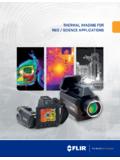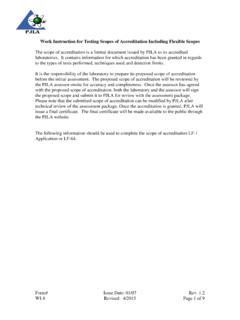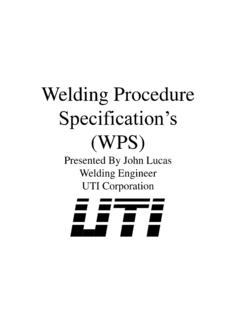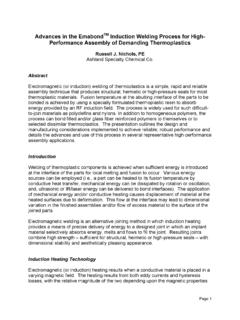Transcription of Composite Defects and Their Detection
1 UNESCO EOLSSSAMPLE CHAPTERSMATERIALS SCIENCE AND ENGINEERING Vol. III Composite Defects and Their Detection - R. A. Smith Encyclopedia of Life Support Systems (EOLSS) Composite Defects AND Their Detection R. A. Smith Structural Materials Centre, QinetiQ Ltd, Cody Technology Park, Farnborough, UK Keywords: Non- destructive testing, composites, ultrasound, thermography, radiography, acoustics, holography, shearography, interferometry. Contents 1. Introduction Scope Defects in Composites Significance of Defects in Composites Detection methods 2. Types of Defect in Composites Manufacturing Defects In-service Defects 3. Ultrasonic Inspection Methods Basic Ultrasonics Choice of Frequency Defect Detection and Characterization Ultrasonic Imaging Techniques Production Inspection Techniques In-service Inspection Techniques Specialist Ultrasonic Techniques 4. Low-frequency Vibration Methods Global Assessment Local Assessment 5.
2 Acoustic Emission and Acousto-Ultrasonics 6. X-Radiography 7. Optical Methods 8. Thermal Methods Thermal Imaging Pulsed Thermography Lock-in Thermography Acknowledgments Glossary Bibliography Biographical Sketches Summary Defects can inadvertently be produced in Composite materials either during the manufacturing process or in the course of the normal service life of the component. The most significant Defects in monolithic structures are porosity, caused by incorrect manufacture, and impact damage during in-service use. For sandwich structures with honeycomb cores the presence of bond failure or core crushing is equally significant. UNESCO EOLSSSAMPLE CHAPTERSMATERIALS SCIENCE AND ENGINEERING Vol. III Composite Defects and Their Detection - R. A. Smith Encyclopedia of Life Support Systems (EOLSS) By far the most commonly used non- destructive test for Composite structures is ultrasonic inspection, often producing a two-dimensional map of the structure.
3 In Composite structures Defects are often in the form of disbonds or delaminations in the plane of the material , or porosity. The reason for favoring ultrasound is that it is very sensitive to these types of defect commonly found in composites. It is one of the few methods available for detecting porosity after manufacture and it can detect most of the other Defects at the same time. Low-frequency vibration methods are utilized for in-service inspection of sandwich structures with honeycomb cores where ultrasound is not sensitive to all the types of defect. For glass-fiber reinforced pressure vessels acoustic emission is in common use for monitoring pressure tests to detect damage. X-ray imaging has some uses for damage characterization where the damage is surface-breaking and a contrast medium can be injected. Numerous other methods are being developed with potential for rapid or large-area inspection capabilities.
4 However, at present, these have limitations that have prevented them being used extensively. Laser ultrasound generation is one of these newer methods, but the cost is currently prohibitive. Optical and thermal methods are not as expensive but have limited depth penetration and are still considerably more expensive than conventional ultrasound methods. 1. Introduction Scope This article deals with manufacturing and in-service Defects in monolithic composites and sandwich structures with honeycomb or foam cores. Because they have yet to be applied extensively, metal-matrix and ceramic-matrix composites will not be considered explicitly in this discussion. The techniques described are applicable to long and short fiber composites although, in general, short fiber composites have a more random arrangement of fibers and are not so susceptible to delamination damage.
5 Most of the current inspection techniques are discussed in the initial overview. The more frequently used methods are then described in detail in the main body of the article. Defects in Composites Defects can inadvertently be produced in Composite materials, either during the manufacturing process or in the course of the normal service life of the component. The manufacturing process has the potential for causing a wide range of Defects , the most common of which is porosity, the presence of small voids in the matrix. Porosity can be caused by incorrect, or non-optimal, cure parameters such as duration, temperature, pressure, or vacuum bleeding of resin. Porosity levels can be critical, as they will affect mechanical performance parameters, such as inter-laminar shear stress. Preparation of the resin-impregnated fiber layers (pre-preg), prior to curing, can be by UNESCO EOLSSSAMPLE CHAPTERSMATERIALS SCIENCE AND ENGINEERING Vol.
6 III Composite Defects and Their Detection - R. A. Smith Encyclopedia of Life Support Systems (EOLSS) hand or machine. In either case there is the potential for the inclusion of foreign bodies ranging from backing film to just greasy marks from fingers. More recent low-cost manufacturing techniques, involving the infusion of resin into pre-formed dry fibers in moulds, have introduced other potential Defects such as fiber misalignment, or waviness, both in the plane of the material and out-of-plane. Stitching of fiber tows (bunches of fibers), to hold them in place and prevent misalignment during cure, can itself introduce numerous regularly-spaced sites for void formation. Sandwich structures with honeycomb or foam cores can suffer from poor bonding of the skin to the core. Disbonds can occur at the skin-to-adhesive interface or at the adhesive-to-core interface.
7 In service damage is most often caused by impacts. In monolithic composites this results in matrix cracking and delaminations of the ply layers. In some cases the surface is punctured, but often this is not the case, despite the internal delamination damage being extensive. Such damage is termed barely-visible impact damage (BVID). Sandwich structures can suffer from the same matrix cracking and delaminations in the skins when impacted, but other types of failure can also occur. For example, disbonding can be caused at the skin-to-adhesive interface. Fillet-bond failure is where the honeycomb-to-adhesive bond is weakened. Core crushing occurs where the impact energy is absorbed by the core, which distorts and folds, often being returned to its original shape but with greatly reduced compressive strength. Significance of Defects in Composites It is clear that in many ways, a Composite can differ from the ideal either during manufacture or in service.
8 The extent to which any of these deviations from ideal should be considered as a defect is a function of the intended use of the material and the significance of the deviation on the required performance. All defect types are known to adversely affect performance in some way. However, the type and size of defect that needs to be found can only be set for each application based on the results of mechanical destructive tests and a detailed knowledge of how such Defects grow, if at all, in the expected service environment. This process sets the acceptance criteria for manufacturing and in-service Defects . It is beyond the scope of this article to discuss the significance of Defects in detail but it should be stressed that defect significance must be assessed before meaningful acceptance and rejection criteria can be established. In order to discuss the use of NDE for composites it will be necessary to assume that some of the Defects mentioned will reach a significant size and must therefore be found.
9 This will be done by taking the conclusions that are emerging from defect significance studies for long fiber CFC materials for aerospace applications. This will serve as a general guide since this is one of the most demanding applications due to the necessity of reducing weight as much as possible. These assumptions may not, however, be applicable to another application or Composite type. Detection methods UNESCO EOLSSSAMPLE CHAPTERSMATERIALS SCIENCE AND ENGINEERING Vol. III Composite Defects and Their Detection - R. A. Smith Encyclopedia of Life Support Systems (EOLSS) For a defect Detection method to be reliable, its response on a defective structure must be significantly different to that on a sound structure. By far the most commonly used non- destructive test for Composite structures is ultrasonic inspection, often producing a two-dimensional C-scan map of the structure.
10 In Composite structures, Defects are most often in the form of either disbonds or delaminations in the plane of the material , or porosity. The reason for favoring ultrasound inspection is that it is very sensitive to these types of defect commonly found in composites. It is also one of the few methods available for detecting porosity and it can detect most of the other Defects at the same time. Low-frequency vibration methods are utilized for in-service inspection of sandwich structures with honeycomb cores where ultrasound is not sensitive to all the types of defect. They are particularly useful as a rapid search tool to detect trouble spots but have difficulty when identifying the type or extent of Defects . For glass-fiber reinforced pressure vessels acoustic emission is in common use for monitoring pressure tests to detect damage. X-ray imaging has some uses for damage characterization where the damage is surface-breaking and a contrast medium can be injected.














